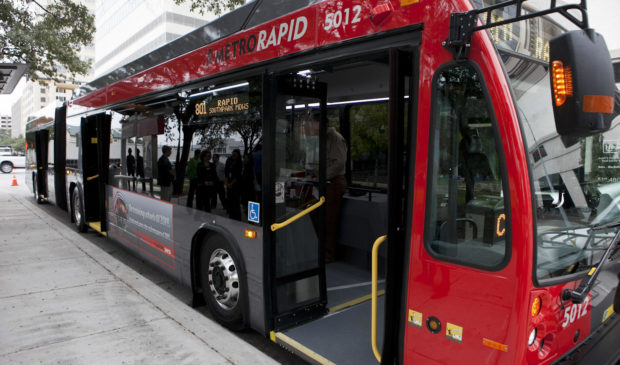Project Connect: Cap Metro insists everything is on the table
Thursday, October 11, 2018 by
Jack Craver Capital Metropolitan Transportation Authority CEO Randy Clarke insists that nothing is set in stone. He has cautioned the community to view the vision document for Project Connect, the long-term plan for high-capacity transit that Capital Metro released last week, as nothing more than the starting point of a lengthy community conversation about how to bring game-changing public transportation to the Austin metropolitan area.
The draft map that Capital Metro released includes seven new routes featuring three distinct modes of transit.
One of the routes is another commuter rail line, similar to the existing Red Line, that would travel from Manor to downtown Austin.
Four of the routes are proposed to be bus rapid transit “light.” BRT involves buses that run in dedicated right of way, with signal prioritization, so that they don’t get stuck in traffic with cars. However, the routes envisioned by Cap Metro would not include dedicated right-of-way, but would include signal prioritization so that buses don’t have to wait at stop lights. The four routes are the following:
-
Yellow Line: Runs between the Domain and the Austin Community College Pinnacle Campus in Southwest Austin.
-
Purple Line: Runs between downtown and Colony Park in Northeast Austin.
-
Pink Line: Runs between Red Bud Trail in West Austin through downtown (along Fifth and Seventh streets) to Airport Boulevard.
-
Navy Line: Runs south from Mueller down Airport Boulevard and then Pleasant Valley Road, all the way down to McKinney Falls in South Austin.
The centerpiece of the plan, however, are the two routes designated as “automated rapid transit.” ART is a vaguely defined technology that has yet to be implemented on a large scale but is being tested out by private and public entities around the world. Clarke has said it could look like “light rail on rubber tires.”
The vision document presents two ART lines. One, the Orange Line, would travel between the North Lamar Transfer Point and Slaughter Lane, mirroring the 801 MetroRapid route, Capital Metro’s most popular route. The second route, the Blue Line, would largely replicate the light rail line that Austin voters rejected in 2014. The proposed route would run south from the east side of the University of Texas campus through downtown to East Riverside, and then go east to the airport. The vision document includes a “potential expansion” north between campus and Austin Community College Highland Campus.
Clarke has stressed that the agency is not committed to ART on those two routes and that over the next two years the agency will evaluate BRT, ART and light rail for all of the major corridors identified in Project Connect.
The most important part of the process, Clark emphasizes, is identifying the corridors where high-capacity transit will go and then taking steps to acquire the necessary right of way.
Despite those assurances, some transit activists interpreted the vision document as yet another indication that Capital Metro is dead set against making another push for light rail. Many of those same activists are adamant that rail is by far the best solution for the city’s most-trafficked corridors, notably Lamar Boulevard/Guadalupe Street.
Other transit supporters have welcomed the conversation about ART, pointing out that Capital Metro is likely years away from being committed to any type of technology and that, if ART is viable by the time the agency has the funds and voter approval to build high-capacity transit, ART could be a cheaper and more flexible alternative to rail.
In his remarks at the unveiling of the vision document last week, Clarke said he believed the technology was much closer to fruition than most people realized.
“Mobility is being disrupted, and we need to harness technology’s potential to really work on our mobility goals,” he said, arguing that Austin, a tech hub, was a natural fit to pioneer new transit technology.
Clarke also noted that the Federal Transit Administration is set to announce grants for autonomous technology in November, a factor that could play in ART’s favor locally.
For now, however, Capital Metro’s goal is not to proselytize but to listen, said Clarke. Project Connect is going to set up its own office downtown and kick off a community engagement effort throughout all of 2019 and into 2020, he said, holding meetings all around the city to hear from people about what would serve them best.
The only thing that Capital Metro is adamant about is that the Austin area cannot continue to depend on cars. The metro area is anticipated to double in population by 2040 – to 4 million – while road capacity is only expected to increase by 15 percent.
“We’re constrained by geometry and we’re constrained by geography,” said Clarke. “There’s really not much more room to build more roads.”
Download (PDF, 889KB)
This story has been updated and changed to reflect the proposal for “light” BRT, which will not have dedicated right of way.
The Austin Monitor’s work is made possible by donations from the community. Though our reporting covers donors from time to time, we are careful to keep business and editorial efforts separate while maintaining transparency. A complete list of donors is available here, and our code of ethics is explained here.
You're a community leader
And we’re honored you look to us for serious, in-depth news. You know a strong community needs local and dedicated watchdog reporting. We’re here for you and that won’t change. Now will you take the powerful next step and support our nonprofit news organization?



